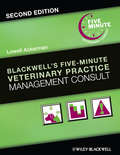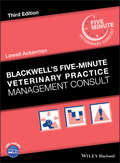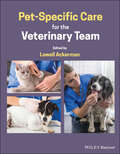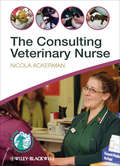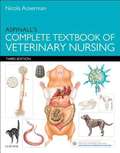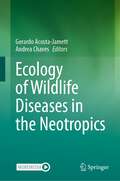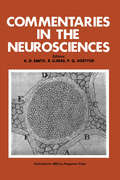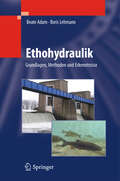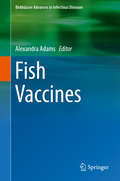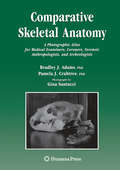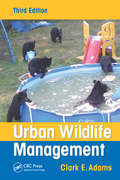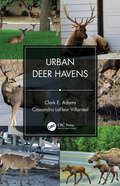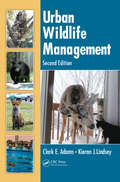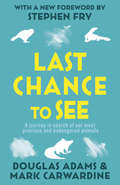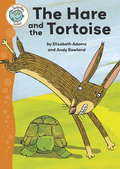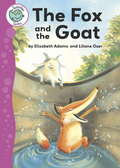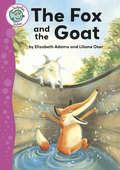- Table View
- List View
Blackwell's Five-Minute Veterinary Practice Management Consult (Blackwell's Five-Minute Veterinary Consult)
by Lowell AckermanBlackwell’s Five-Minute Veterinary Practice Management Consult, Second Edition has been extensively updated and expanded, with 55 new topics covering subjects such as online technologies, hospice care, mobile practices, compassion fatigue, practice profitability, and more. Carefully formatted using the popular Five-Minute Veterinary Consult style, the book offers fast access to authoritative information on all aspects of practice management. This Second Edition is an essential tool for running a practice, increasing revenue, and managing staff in today’s veterinary practice. Addressing topics ranging from client communication and management to legal issues, financial management, and human resources, the book is an invaluable resource for business management advice applicable to veterinary practice. Sample forms and further resources are now available on a companion website. Veterinarians and practice managers alike will find this book a comprehensive yet user-friendly guide for success in today’s challenging business environment.
Blackwell's Five-Minute Veterinary Practice Management Consult (Blackwell's Five-Minute Veterinary Consult)
by Lowell AckermanBlackwell’s Five-Minute Veterinary Practice Management Consult, Second Edition has been extensively updated and expanded, with 55 new topics covering subjects such as online technologies, hospice care, mobile practices, compassion fatigue, practice profitability, and more. Carefully formatted using the popular Five-Minute Veterinary Consult style, the book offers fast access to authoritative information on all aspects of practice management. This Second Edition is an essential tool for running a practice, increasing revenue, and managing staff in today’s veterinary practice. Addressing topics ranging from client communication and management to legal issues, financial management, and human resources, the book is an invaluable resource for business management advice applicable to veterinary practice. Sample forms and further resources are now available on a companion website. Veterinarians and practice managers alike will find this book a comprehensive yet user-friendly guide for success in today’s challenging business environment.
Blackwell's Five-Minute Veterinary Practice Management Consult (Blackwell's Five-Minute Veterinary Consult)
by Lowell AckermanProvides a quick veterinary reference to all things practice management related, with fast access to pertinent details on human resources, financial management, communications, facilities, and more Blackwell's Five-Minute Veterinary Practice Management Consult, Third Edition provides quick access to practical information for managing a veterinary practice. It offers 320 easily referenced topics that present essential details for all things practice management—from managing clients and finances to information technology, legal issues, and planning. This fully updated Third Edition adds 26 new topics, with a further 78 topics significantly updated or expanded. It gives readers a look at the current state of the veterinary field, and teaches how to work in teams, communicate with staff and clients, manage money, market a practice, and more. It also provides professional insight into handling human resources in a veterinary practice, conducting staff performance evaluations, facility design and construction, and managing debt, among other topics. KEY FEATURES: Presents essential information on veterinary practice management in an easy-to-use format Offers a practical support tool for the business aspects of veterinary medicine Includes 26 brand-new topics and 78 significantly updated topics Provides models of veterinary practice, challenges to the profession, trends in companion practices, and more Features contributions from experts in veterinary practice, human resources, law, marketing, and more Supplies sample forms and other resources digitally on a companion website Blackwell's Five-Minute Veterinary Practice Management Consult offers a trusted, user-friendly resource for all aspects of business management, carefully tailored for the veterinary practice. It is a vital resource for any veterinarian or staff member involved in practice management.
Blackwell's Five-Minute Veterinary Practice Management Consult (Blackwell's Five-Minute Veterinary Consult)
by Lowell AckermanProvides a quick veterinary reference to all things practice management related, with fast access to pertinent details on human resources, financial management, communications, facilities, and more Blackwell's Five-Minute Veterinary Practice Management Consult, Third Edition provides quick access to practical information for managing a veterinary practice. It offers 320 easily referenced topics that present essential details for all things practice management—from managing clients and finances to information technology, legal issues, and planning. This fully updated Third Edition adds 26 new topics, with a further 78 topics significantly updated or expanded. It gives readers a look at the current state of the veterinary field, and teaches how to work in teams, communicate with staff and clients, manage money, market a practice, and more. It also provides professional insight into handling human resources in a veterinary practice, conducting staff performance evaluations, facility design and construction, and managing debt, among other topics. KEY FEATURES: Presents essential information on veterinary practice management in an easy-to-use format Offers a practical support tool for the business aspects of veterinary medicine Includes 26 brand-new topics and 78 significantly updated topics Provides models of veterinary practice, challenges to the profession, trends in companion practices, and more Features contributions from experts in veterinary practice, human resources, law, marketing, and more Supplies sample forms and other resources digitally on a companion website Blackwell's Five-Minute Veterinary Practice Management Consult offers a trusted, user-friendly resource for all aspects of business management, carefully tailored for the veterinary practice. It is a vital resource for any veterinarian or staff member involved in practice management.
Pet-Specific Care for the Veterinary Team
by Lowell AckermanA practical guide to identifying risks in veterinary patients and tailoring their care accordingly Pet-specific care refers to a practice philosophy that seeks to proactively provide veterinary care to animals throughout their lives, aiming to keep pets healthy and treat them effectively when disease occurs. Pet-Specific Care for the Veterinary Team offers a practical guide for putting the principles of pet-specific care into action. Using this approach, the veterinary team will identify risks to an individual animal, based on their particular circumstances, and respond to these risks with a program of prevention, early detection, and treatment to improve health outcomes in pets and the satisfaction of their owners. The book combines information on medicine and management, presenting specific guidelines for appropriate medical interventions and material on how to improve the financial health of a veterinary practice in the process. Comprehensive in scope, and with expert contributors from around the world, the book covers pet-specific care prospects, hereditary and non-hereditary considerations, customer service implications, hospital and hospital team roles, and practice management aspects of pet-specific care. It also reviews specific risk factors and explains how to use these factors to determine an action plan for veterinary care. This important book: Offers clinical guidance for accurately assessing risks for each patient Shows how to tailor veterinary care to address a patient’s specific risk factors Emphasizes prevention, early detection, and treatment Improves treatment outcomes and provides solutions to keep pets healthy and well Written for veterinarians, technicians and nurses, managers, and customer service representatives, Pet-Specific Care for the Veterinary Team offers a hands-on guide to taking a veterinary practice to the next level of care.
Pet-Specific Care for the Veterinary Team
by Lowell AckermanA practical guide to identifying risks in veterinary patients and tailoring their care accordingly Pet-specific care refers to a practice philosophy that seeks to proactively provide veterinary care to animals throughout their lives, aiming to keep pets healthy and treat them effectively when disease occurs. Pet-Specific Care for the Veterinary Team offers a practical guide for putting the principles of pet-specific care into action. Using this approach, the veterinary team will identify risks to an individual animal, based on their particular circumstances, and respond to these risks with a program of prevention, early detection, and treatment to improve health outcomes in pets and the satisfaction of their owners. The book combines information on medicine and management, presenting specific guidelines for appropriate medical interventions and material on how to improve the financial health of a veterinary practice in the process. Comprehensive in scope, and with expert contributors from around the world, the book covers pet-specific care prospects, hereditary and non-hereditary considerations, customer service implications, hospital and hospital team roles, and practice management aspects of pet-specific care. It also reviews specific risk factors and explains how to use these factors to determine an action plan for veterinary care. This important book: Offers clinical guidance for accurately assessing risks for each patient Shows how to tailor veterinary care to address a patient’s specific risk factors Emphasizes prevention, early detection, and treatment Improves treatment outcomes and provides solutions to keep pets healthy and well Written for veterinarians, technicians and nurses, managers, and customer service representatives, Pet-Specific Care for the Veterinary Team offers a hands-on guide to taking a veterinary practice to the next level of care.
The Consulting Veterinary Nurse
by Nicola AckermanThe Consulting Veterinary Nurse is an invaluable source of information for all veterinary nurses setting up and conducting their own nursing clinics in small animal practice. From the basics of setting up the consulting room to running and marketing individual clinics, this book provides a comprehensive coverage of the role of the consulting veterinary nurse. A large section of the book details specific clinics run by nurses, including nutritional assessments, behavioural clinics, puppy parties, seasonal information campaigns, senior pet clinics and medical clinics for a full range of conditions from arthritis and dental problems to epilepsy and cancer. A chapter specifically on rabbit clinics is also included. Written by an experienced senior veterinary nurse, this is a vital guide for all veterinary nurses seeking to develop their consulting role and contribute effectively to the long-term success of their practice. KEY FEATURES Provides a comprehensive guide to the role of the consulting veterinary nurse Details specific nutritional, medical and behavioural clinics run by nurses Includes advice on presentation, marketing and communicating with clients Discusses client compliance and internal procedure and protocol Contains sample diet history sheets and unit conversion charts for use in practice Endorsed by the British Veterinary Nursing Association
The Consulting Veterinary Nurse
by Nicola AckermanThe Consulting Veterinary Nurse is an invaluable source of information for all veterinary nurses setting up and conducting their own nursing clinics in small animal practice. From the basics of setting up the consulting room to running and marketing individual clinics, this book provides a comprehensive coverage of the role of the consulting veterinary nurse. A large section of the book details specific clinics run by nurses, including nutritional assessments, behavioural clinics, puppy parties, seasonal information campaigns, senior pet clinics and medical clinics for a full range of conditions from arthritis and dental problems to epilepsy and cancer. A chapter specifically on rabbit clinics is also included. Written by an experienced senior veterinary nurse, this is a vital guide for all veterinary nurses seeking to develop their consulting role and contribute effectively to the long-term success of their practice. KEY FEATURES Provides a comprehensive guide to the role of the consulting veterinary nurse Details specific nutritional, medical and behavioural clinics run by nurses Includes advice on presentation, marketing and communicating with clients Discusses client compliance and internal procedure and protocol Contains sample diet history sheets and unit conversion charts for use in practice Endorsed by the British Veterinary Nursing Association
Aspinall's Complete Textbook Of Veterinary Nursing (PDF)
by Nicola Ackerman Victoria AspinallThe third edition of Aspinall's Complete Textbook of Veterinary Nursing is the ideal text for both student and qualified veterinary nurses as it covers the entire veterinary nursing syllabus. Now written in the main by veterinary nurses this book comprehensively covers all aspects of the veterinary nursing role from client communication to nutritional support. All chapters have been revised in line with changes in legislation and regulation, but also theoretical and practical aspects. Greater emphasis on the veterinary practice structure including the role of corporate businesses and use of social media bring this edition fully up to date. The new edition welcomes Nicola Ackerman as principal editor. Nicola is past officer of the BVNA and editor of the Veterinary Nursing Journal, and is currently the chair of The Pet Obesity Taskforce. Nicola is a winner of several awards including the Blue Cross/BVNA Veterinary Nurse of the Year 2010. Nicola was the first Veterinary Nurse in the UK to become a veterinary nurse specialist in nutrition. Comprehensive content ideal for both student and qualified veterinary nurses Over 700 full colour illustrations for enhanced understanding Written by veterinary nurses for veterinary nurses Recommended reading given for each chapter to aid further research Evolve Resources containing Self-assessment questions for every chapter to test learning Image Bank of over 700 figures Additional chapters New chapters on Emergency Critical care, Fluid therapy, Practice and Staff management and Consulting skills. Anaesthesia and Analgesia chapter fully revised and updated. New chapter on Equine Behaviour and Handling, including recognition of pain in equines.
Ecology of Wildlife Diseases in the Neotropics
by Gerardo Acosta-Jamett Andrea ChavesThis contributed volume focuses on the Neotropical region, and explores the environmental, ecological and socio-economic components that facilitate the emergence of zoonotic diseases. This book highlights the primary ecological, environmental, social, and economic variables associated with the risk of maintenance, transmission, and dissemination of emerging, re-emerging, and neglected infectious diseases, in which Neotropical vertebrates are involved. It compiles up-to-date knowledge and research for the neotropical region, as well as discusses the current needs of knowledge improvement. The chapters include various examples of the cycles of infectious diseases, all with world-wide relevance where neotropical wild vertebrates are affected or involved.
Commentaries in the Neurosciences
by A.D. SMITH, R. LLINÁS, P.G. KOSTYUKCommentaries in the Neurosciences is a compilation of the commentaries segment featured in the Neuroscience journal. This book, however, does not provide a comprehensive account of all fields in neuroscience, but rather articles that highlight developments during the past years. The topics covered include chemistry and dynamics of neurotransmitter storage particles; release of central and peripheral neurotransmitters; and transmitters in the enteric nervous system. This book also discusses the properties of neuroreceptors; chemistry and connections of the cerebral cortex; and intracellular recording and ionic transmembrane currents. This text explains as well the invertebrate nervous systems; functions of the nervous system including neuro- and psychopharmacology; and the mind-body problem. This book will be of use not only to research workers interested in keeping updated with developments in different areas of the neurosciences, but also to advanced undergraduate and graduate students who are studying the nervous system.
Ethohydraulik: Grundlagen, Methoden und Erkenntnisse
by Beate Adam Boris LehmannUm Fließgewässer den Nutzungsansprüchen des Menschen anzupassen, sind unzählige Baumaßnahmen erforderlich. Um die Auswirkungen wasserbaulicher Aktivitäten auf die in Fließgewässern lebenden Tiere zu untersuchen, wurde die Ethohydraulik entwickelt. Sie beruht auf der Ethologie (Erforschung des Verhaltens von Tieren) und der Hydraulik (Lehre von den bewegten Flüssigkeiten). Die Autoren stellen die Grundlagen dieser Wissenschaftsdisziplin dar und liefern Regeln sowie Grenz- und Bemessungswerte für die wasserbauliche Praxis.
Zum Umgang mit aquatischen Organismen: Versuchstierkundliche Grundlagen
by Beate Adam Maren Schürmann Ulrich SchweversDas Tierschutzgesetz fordert, dass im Namen der Verantwortung des Menschen seinen Mitgeschöpfen wissentlich weder Schmerzen noch Leiden zugefügt werden dürfen. Dies gilt auch für den Umgang mit zehnfüßigen Krebsen, Neunaugen und Fischen. Den Bedürfnissen dieser aquatischen Organismen wird allerdings bislang sowohl im Bereich der gewässerökologischen Feldforschung als auch in der ökotoxikologischen und genetischen Laborarbeit wenig Aufmerksamkeit geschenkt. Vor diesem Hintergrund stellen die Autoren die Gültigkeit des Tierschutzes auch für aquatische Versuchstiere in den verschiedenen Einsatzgebieten dar. Neben Aspekten der Beantragung eines Tierversuches befassen sie sich mit Fragen zur Beschaffung, Hälterung und dem Umgang mit Krebsen, Neunaugen und Fischen. Darüber hinaus werden im Sinne eines Handbuches die gebräuchlichsten Markierungsmethoden sowie die für diese Eingriffe erforderlichen Techniken Schritt für Schritt erläutert. Ziel ist es, mit dem Buch ein besseres Verständnis für aquatische Organismen und ihre Bedürfnissen zu wecken und einen Standard für den schonenden Umgang mit solchen Versuchstieren zu setzen.
Arbeiten der Lehrkanzel für Tierzucht an der Hochschule für Bodenkultur in Wien: Dritter Band
by L AdametzDieser Buchtitel ist Teil des Digitalisierungsprojekts Springer Book Archives mit Publikationen, die seit den Anfängen des Verlags von 1842 erschienen sind. Der Verlag stellt mit diesem Archiv Quellen für die historische wie auch die disziplingeschichtliche Forschung zur Verfügung, die jeweils im historischen Kontext betrachtet werden müssen. Dieser Titel erschien in der Zeit vor 1945 und wird daher in seiner zeittypischen politisch-ideologischen Ausrichtung vom Verlag nicht beworben.
Fish Vaccines (Birkhäuser Advances in Infectious Diseases)
by Alexandra AdamsThis book provides a useful text for research students and scientists on the latest knowledge about the immune system of fish, cutting edge technologies and the step required to develop, test and commercialise fish vaccines. It brings together information that is currently difficult to obtain in one book, and highlights problem areas and research topics that still need to be addressed to improve future vaccines.
Comparative Skeletal Anatomy: A Photographic Atlas for Medical Examiners, Coroners, Forensic Anthropologists, and Archaeologists
by Bradley J. Adams Pamela J. CrabtreeThis is a photographic atlas of common animal bones, designed for use by the forensic scientist or archaeologist. This volume is the first to focus comparatively on both human and animal osteology. It features more than 300 illustrations of skeletons. Throughout, animal bones are photographed alongside the corresponding human bone, allowing the reader to observe size and shape variations.
Urban Wildlife Management
by Clark E. AdamsWinner of the 2018 TWS Wildlife Publication Awards in the authored book category Urban development is one of the leading worldwide threats to conserving biodiversity. In the near future, wildlife management in urban landscapes will be a prominent issue for wildlife professionals. This new edition of Urban Wildlife Management continues the work of its predecessors by providing a comprehensive examination of the issues that increase the need for urban wildlife management, exploring the changing dynamics of the field while giving historical perspectives and looking at current trends and future directions. The book examines a range of topics on human interactions with wildlife in urbanized environments. It focuses not only on ecological matters but also on political, economic, and societal issues that must be addressed for successful management planning. This edition features an entirely new section on urban wildlife species, including chapters on urban communities, herpetofauna, birds, ungulates, mammals, carnivores, and feral and introduced species. The third edition features Five new chapters 12 updated chapters Four new case studies Seven new appendices and species profiles 90 new figures A comprehensive analysis of terrestrial vertebrate locations by state and urban observations Each chapter opens with a set of key concepts which are then examined in the following discussions. Suggested learning experiences to enhance knowledge conclude each chapter. The species profiles cover not only data about the animal concerned but also detail significant current management issues related to the species. An updated and expanded teaching tool, Urban Wildlife Management, Third Edition identifies the challenges and opportunities facing wildlife in urban communities as well as factors that promote or threaten their presence. It gives both students and professionals a solid grounding in the required fundamental ecological principles for understanding the effects of human-made environments on wildlife.
Urban Wildlife Management
by Clark E. AdamsWinner of the 2018 TWS Wildlife Publication Awards in the authored book category Urban development is one of the leading worldwide threats to conserving biodiversity. In the near future, wildlife management in urban landscapes will be a prominent issue for wildlife professionals. This new edition of Urban Wildlife Management continues the work of its predecessors by providing a comprehensive examination of the issues that increase the need for urban wildlife management, exploring the changing dynamics of the field while giving historical perspectives and looking at current trends and future directions. The book examines a range of topics on human interactions with wildlife in urbanized environments. It focuses not only on ecological matters but also on political, economic, and societal issues that must be addressed for successful management planning. This edition features an entirely new section on urban wildlife species, including chapters on urban communities, herpetofauna, birds, ungulates, mammals, carnivores, and feral and introduced species. The third edition features Five new chapters 12 updated chapters Four new case studies Seven new appendices and species profiles 90 new figures A comprehensive analysis of terrestrial vertebrate locations by state and urban observations Each chapter opens with a set of key concepts which are then examined in the following discussions. Suggested learning experiences to enhance knowledge conclude each chapter. The species profiles cover not only data about the animal concerned but also detail significant current management issues related to the species. An updated and expanded teaching tool, Urban Wildlife Management, Third Edition identifies the challenges and opportunities facing wildlife in urban communities as well as factors that promote or threaten their presence. It gives both students and professionals a solid grounding in the required fundamental ecological principles for understanding the effects of human-made environments on wildlife.
Urban Deer Havens
by Clark E. Adams Cassandra LaFleur VillarrealUrban Deer Havens consists of a thorough examination of selected cervid (deer) species that are known to inhabit urban communities in the United States. The deer species that are included in this presentation consisted of white-tailed (Odocoileus virginianus), Key deer (O. v. clavium), moose (Alces alces), elk (Cervus elaphus), mule (Odocoileus hemionus), and black-tailed deer (O. h. columbianus). This book is the first attempt to examine the similarities and differences in those factors that allow the selected cervids to exist and thrive in urban habitats. This information has never been collected, collated, reviewed, and published under one cover document. Yet, all five are known to inhabit urban communities within their geographic range. The lack of information concerning several important examples of urban cervids in conjunction with a proliferation of information on white-tailed deer only is an incomplete and biased presentation. This book is the first comprehensive source of information on urban deer management, which includes a broad assemblage of urban cervids. The overall objective of this book is to provide a more holistic examination of urban cervids. For example, it examines the similarities and differences of the environmental impacts, management strategies, and human dimensions considerations concerning urban cervids in general, and using specific examples. Urban Deer Havens features four chapters that include: Urban deer census techniques and population dynamics Comprehensive tables that review urban community deer management plans National and state-wide estimates the five selected cervids Laws and regulations concerning urban deer Lethal and nonlethal management options for managing deer Steps for managing urban deer populations Examples of urban deer management efforts
Urban Deer Havens
by Clark E. Adams Cassandra LaFleur VillarrealUrban Deer Havens consists of a thorough examination of selected cervid (deer) species that are known to inhabit urban communities in the United States. The deer species that are included in this presentation consisted of white-tailed (Odocoileus virginianus), Key deer (O. v. clavium), moose (Alces alces), elk (Cervus elaphus), mule (Odocoileus hemionus), and black-tailed deer (O. h. columbianus). This book is the first attempt to examine the similarities and differences in those factors that allow the selected cervids to exist and thrive in urban habitats. This information has never been collected, collated, reviewed, and published under one cover document. Yet, all five are known to inhabit urban communities within their geographic range. The lack of information concerning several important examples of urban cervids in conjunction with a proliferation of information on white-tailed deer only is an incomplete and biased presentation. This book is the first comprehensive source of information on urban deer management, which includes a broad assemblage of urban cervids. The overall objective of this book is to provide a more holistic examination of urban cervids. For example, it examines the similarities and differences of the environmental impacts, management strategies, and human dimensions considerations concerning urban cervids in general, and using specific examples. Urban Deer Havens features four chapters that include: Urban deer census techniques and population dynamics Comprehensive tables that review urban community deer management plans National and state-wide estimates the five selected cervids Laws and regulations concerning urban deer Lethal and nonlethal management options for managing deer Steps for managing urban deer populations Examples of urban deer management efforts
Urban Wildlife Management
by Clark E. Adams Kieran J. LindseyWhen the first edition of Urban Wildlife Management was published two years ago, it provided conservationists, ecologists, and wildlife professionals with a welcome shift in the way that interactions between humans and wildlife were viewed and managed. Instead of focusing on ways to evict or eradicate wildlife encroached on by urban development, th
Last Chance To See
by Douglas Adams Mark Carwardine'Douglas Adams' genius was in using comedy to make serious points about the world' IndependentAfter years of reflecting on the absurdities of life on other planets, Douglas Adams teamed up with zoologist Mark Carwardine to find out what was happening to life on this one. Together they lead us on an unforgettable journey across the world in search of exotic, endangered creatures - animals that they may never get another chance to see. They encounter the animal kingdom in its stunning beauty, astonishing variety, and imminent peril: the giant Komodo dragon of Indonesia, the helpless but lovable Kakapo of New Zealand, the blind river dolphins of China, the white rhinos of Zaire, the rare birds of Mauritius island in the Indian Ocean. Both funny and poignant, Last Chance to See is the tale of an unforgettable wildlife odyssey - and a timely reminder of all that we must protect.
Aesop's Fables: Tadpoles Tales: Aesop's Fables (Tadpoles Tales #29)
by Elizabeth AdamsA simple retelling of a favourite Aesop fable. Hare thinks he is much quicker than Tortoise and never stops teasing her. But what will happen when they have a race?
Aesop's Fables: Tadpoles Tales: Aesop's Fables (Tadpoles Tales #28)
by Elizabeth AdamsA simple retelling of a favourite Aesop fable. Fox is trapped in a well and he tricks Goat into joining him. But can he trick Goat again to get out?
Aesop's Fables: Aesop's Fables: The Fox And The Goat - Ebook (Tadpoles Tales #95)
by Elizabeth AdamsA simple retelling of a favourite Aesop fable. Fox is trapped in a well and he tricks Goat into joining him. But can he trick Goat again to get out?
